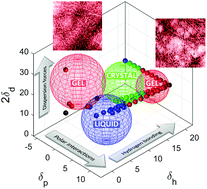Our official English website, www.x-mol.net, welcomes your
feedback! (Note: you will need to create a separate account there.)
Self-assembly pathways and polymorphism in peptide-based nanostructures†
Nanoscale ( IF 5.8 ) Pub Date : 2017-12-22 00:00:00 , DOI: 10.1039/c7nr06724k Nikola A. Dudukovic 1, 2, 3, 4, 5 , Benjamin C. Hudson 3, 6, 7, 8 , Anant K. Paravastu 3, 6, 7, 8 , Charles F. Zukoski 3, 9, 10, 11
Nanoscale ( IF 5.8 ) Pub Date : 2017-12-22 00:00:00 , DOI: 10.1039/c7nr06724k Nikola A. Dudukovic 1, 2, 3, 4, 5 , Benjamin C. Hudson 3, 6, 7, 8 , Anant K. Paravastu 3, 6, 7, 8 , Charles F. Zukoski 3, 9, 10, 11
Affiliation

|
Dipeptide derivative molecules can self-assemble into space-filling nanofiber networks at low volume fractions (<1%), allowing the formation of molecular gels with tunable mechanical properties. The self-assembly of dipeptide-based molecules is reminiscent of pathological amyloid fibril formation by naturally occurring polypeptides. Fluorenylmethoxycarbonyl-diphenylalanine (Fmoc-FF) is the most widely studied such molecule, but the thermodynamic and kinetic phenomena giving rise to Fmoc-FF gel formation remain poorly understood. We have previously presented evidence that the gelation process is a first order phase transition characterized by low energy barriers to nucleation, short induction times, and rapid quasi-one-dimensional crystal growth, stemming from solvent–solute interactions and highly specific molecular packing. Here, we discuss the phase behavior of Fmoc-FF in different solvents. We find that Fmoc-FF gel formation can be induced in apolar solvents, in addition to previously established pathways in aqueous systems. We further show that in certain solvent systems anisotropic crystals (nanofibers) are an initial metastable state, after which macroscopic crystal aggregates with no preferred axis of growth are formed. The molecular conformation is sensitive to solvent composition during assembly, indicating that Fmoc-FF may be a simple model system to study complex thermodynamic and kinetic phenomena involved in peptide self-assembly.
中文翻译:

基于肽的纳米结构的自组装途径和多态性†
二肽衍生物分子可以以低体积分数(<1%)自组装成充满空间的纳米纤维网络,从而可以形成具有可调机械性能的分子凝胶。基于二肽的分子的自组装使人联想到天然存在的多肽引起的病理性淀粉样蛋白原纤维的形成。芴基甲氧基羰基-二苯丙氨酸(Fmoc-FF)是研究最广泛的此类分子,但引起Fmoc-FF凝胶形成的热力学和动力学现象仍然知之甚少。我们之前已经提供了证据,表明胶凝过程是一阶相变,其特征在于成核的能量垒低,诱导时间短,并且由于溶剂-溶质相互作用和高度特异性的分子堆积而导致的准一维晶体快速生长。这里,我们讨论了Fmoc-FF在不同溶剂中的相行为。我们发现,Fmoc-FF凝胶的形成可以在非极性溶剂中诱导,除了之前在水性体系中建立的途径外。我们进一步表明,在某些溶剂系统中,各向异性晶体(纳米纤维)为初始亚稳态,此后形成没有优选生长轴的宏观晶体聚集体。分子构象对组装过程中的溶剂组成敏感,表明Fmoc-FF可能是研究肽自组装涉及的复杂热力学和动力学现象的简单模型系统。我们进一步表明,在某些溶剂系统中,各向异性晶体(纳米纤维)为初始亚稳态,此后形成没有优选生长轴的宏观晶体聚集体。分子构象对组装过程中的溶剂组成敏感,表明Fmoc-FF可能是研究肽自组装涉及的复杂热力学和动力学现象的简单模型系统。我们进一步表明,在某些溶剂系统中,各向异性晶体(纳米纤维)为初始亚稳态,此后形成没有优选生长轴的宏观晶体聚集体。分子构象对组装过程中的溶剂组成敏感,表明Fmoc-FF可能是研究肽自组装涉及的复杂热力学和动力学现象的简单模型系统。
更新日期:2017-12-22
中文翻译:

基于肽的纳米结构的自组装途径和多态性†
二肽衍生物分子可以以低体积分数(<1%)自组装成充满空间的纳米纤维网络,从而可以形成具有可调机械性能的分子凝胶。基于二肽的分子的自组装使人联想到天然存在的多肽引起的病理性淀粉样蛋白原纤维的形成。芴基甲氧基羰基-二苯丙氨酸(Fmoc-FF)是研究最广泛的此类分子,但引起Fmoc-FF凝胶形成的热力学和动力学现象仍然知之甚少。我们之前已经提供了证据,表明胶凝过程是一阶相变,其特征在于成核的能量垒低,诱导时间短,并且由于溶剂-溶质相互作用和高度特异性的分子堆积而导致的准一维晶体快速生长。这里,我们讨论了Fmoc-FF在不同溶剂中的相行为。我们发现,Fmoc-FF凝胶的形成可以在非极性溶剂中诱导,除了之前在水性体系中建立的途径外。我们进一步表明,在某些溶剂系统中,各向异性晶体(纳米纤维)为初始亚稳态,此后形成没有优选生长轴的宏观晶体聚集体。分子构象对组装过程中的溶剂组成敏感,表明Fmoc-FF可能是研究肽自组装涉及的复杂热力学和动力学现象的简单模型系统。我们进一步表明,在某些溶剂系统中,各向异性晶体(纳米纤维)为初始亚稳态,此后形成没有优选生长轴的宏观晶体聚集体。分子构象对组装过程中的溶剂组成敏感,表明Fmoc-FF可能是研究肽自组装涉及的复杂热力学和动力学现象的简单模型系统。我们进一步表明,在某些溶剂系统中,各向异性晶体(纳米纤维)为初始亚稳态,此后形成没有优选生长轴的宏观晶体聚集体。分子构象对组装过程中的溶剂组成敏感,表明Fmoc-FF可能是研究肽自组装涉及的复杂热力学和动力学现象的简单模型系统。











































 京公网安备 11010802027423号
京公网安备 11010802027423号